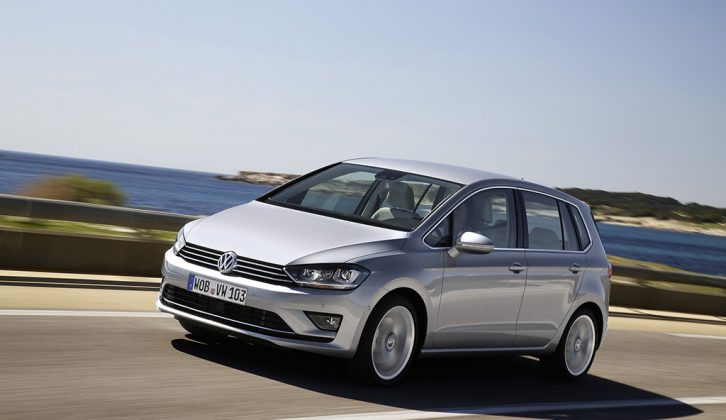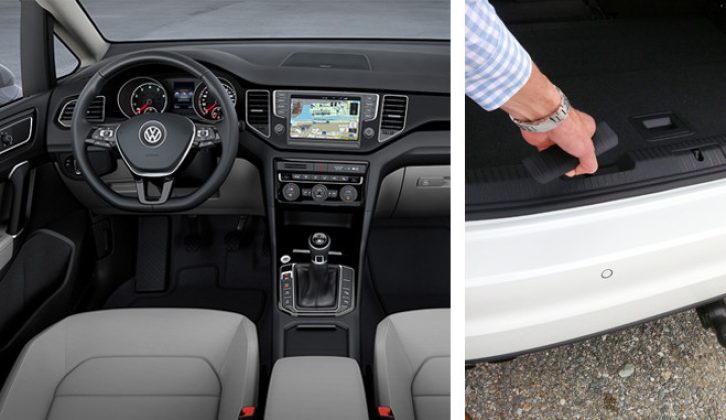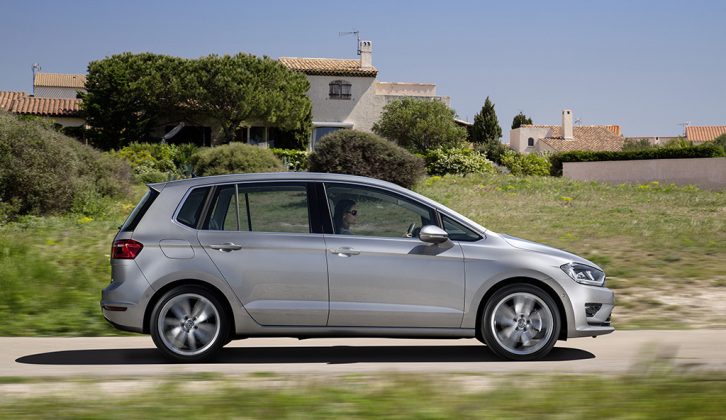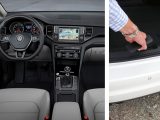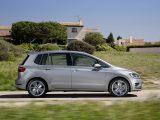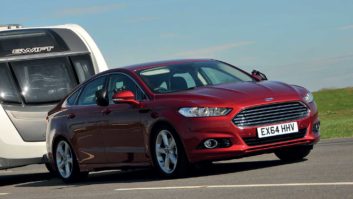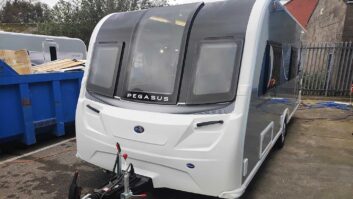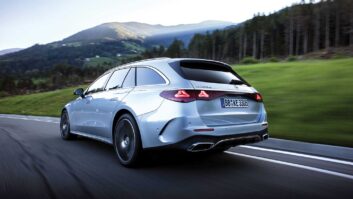The new Volkswagen Golf SV is the third member of the Golf Mk7 family, and replaces the Golf Plus.
If you’re not familiar with the Plus, that’s no great surprise. Towards the end of its life it only accounted for 3% of all Golf sales in the UK, and its stand-out feature was its complete lack of any stand-out feature. Not quite an MPV, not quite a crossover, the Golf Plus was a slightly larger, more practical Golf.
The new Volkswagen Golf SV follows the same formula – and is equally hard to categorise. In Europe it’s referred to as the Golf Sportvan, but in the UK the abbreviation avoids any confusion with a souped-up commercial vehicle.
Whatever its name, the new Golf SV certainly looks more distinctive than its slab-sided predecessor. The sharply creased bodywork does a good job of disguising the car’s height (it’s 126mm or around five inches higher than the Golf hatchback), and VW’s designers have succeeded in injecting more personality into the design.
Practicality comes first with a car like this, though. There’s an extra 48mm (just under two inches) between the front and rear axle, which frees up extra rear legroom. There’s more headroom, too, and the large glass area lets plenty of light into the cabin. Even small children should enjoy a good view out.
The rear bench is split 40/20/40 and slides back and forth on runners to trade legroom for boot space. With the rear seats all the way back there’s 500 litres, rising to 590 litres with the seats forward. With the bench folded there’s 1520 litres to fill.
In the front of the car, the dashboard looks familiar if you’ve driven another Mk7 Golf, although the centre console isn’t angled towards the driver to the same extent as in the hatchback or estate. VW’s designers say this is because the SV is ‘space-oriented’ rather than ‘driver-oriented’. Build quality is up to the same high standard as the rest of the Golf family, while the high-set seating position will suit less agile drivers and gives a good view out.
To drive, the new Volkswagen Golf SV feels little different from the hatch on which it is based. Despite the car’s extra height and length, it’s an agile car and corners with little roll. The steering is precise and body movements are well controlled.
It’s a shame all the cars on the press launch were fitted with the optional adaptive dampers (which cost £815), as far more buyers are expected to stick with the standard suspension set up. However, there’s no doubt the adaptive system, which offers a choice of sporty or softer set ups, provides a comfortable but well controlled ride. That bodes well for stability when towing caravans.
Kerbweights are up slightly compared with the hatchback’s. The petrol line-up starts with an 85PS (84bhp) 1.2 TSI, with a kerbweight of 1320kg and a legal towing limit of 1100kg. I drove the 125PS (124bhp) 1.4 TSI, with a kerbweight of 1362kg and a 1400kg legal towing limit. It’s a lively, flexible and refined engine, which should make a decent fist of pulling light caravans.
The diesels are more likely tow cars, though. The 110PS (109bhp) 1.6 TDI is expected to be the best seller, although unfortunately none were available to test drive. Manual cars have a kerbweight of 1420kg, an 85% match figure of 1207kg and a 1500kg legal towing limit. The 150PS (148bhp) 2.0-litre manual has a kerbweight of 1474kg, an 85% match figure of 1253kg and a legal towing limit of 1600kg. All cars have an 80kg noseweight limit.
I tested the 2.0-litre diesel with both a manual gearbox and the slick-shifting DSG automatic. In everyday driving there’s plenty of punch, and from past experience towing with other Volkswagen Golf models fitted with this engine, there’s more than enough muscle to comfortably pull any suitably matched caravan.
One of the cars I drove was fitted with the factory-fit towball – a very neat, retractable design. Pull a catch in the boot and the towball and integrated electrics drop down, although it takes a quick kick to firmly fix the ball in place. Pull the same catch to unlock the ball, and guide it back out of sight with your hand or foot. It’s worth noting that this won’t be available immediately, though: you’ll need to wait until the end of the year or early 2015 for the factory-fit towball on right-hand drive cars.
If you think the new Volkswagen Golf SV might be the answer to the question ‘what tow car should I buy?’, you will want to know what you’re going to have to spend. Prices start at £18,875. That buys you the basic S spec with the least powerful 1.2-litre petrol engine, with seven airbags, air conditioning, Bluetooth connectivity and a digital radio. The 110PS 1.6-litre diesel starts from £21,650, while the 150PS 2.0-litre diesel is priced from £23,950. The order books are open now, with the first customer deliveries due in late July.
There’s no doubt the new Volkswagen Golf SV is a much better car than its anonymous predecessor. It still suffers slightly from being neither one thing nor the other. The cabin isn’t as flexible or as clever as that of the best MPVs, and there’s not as much boot space as you’ll find in many estate cars. But if the idea of a conventional hatchback with a high seating position and a bit more space appeals, the SV is a capable addition to the Golf family.
The new Volkswagen Golf SV's rear bench slides back and forth on runners, to trade legroom for boot space
